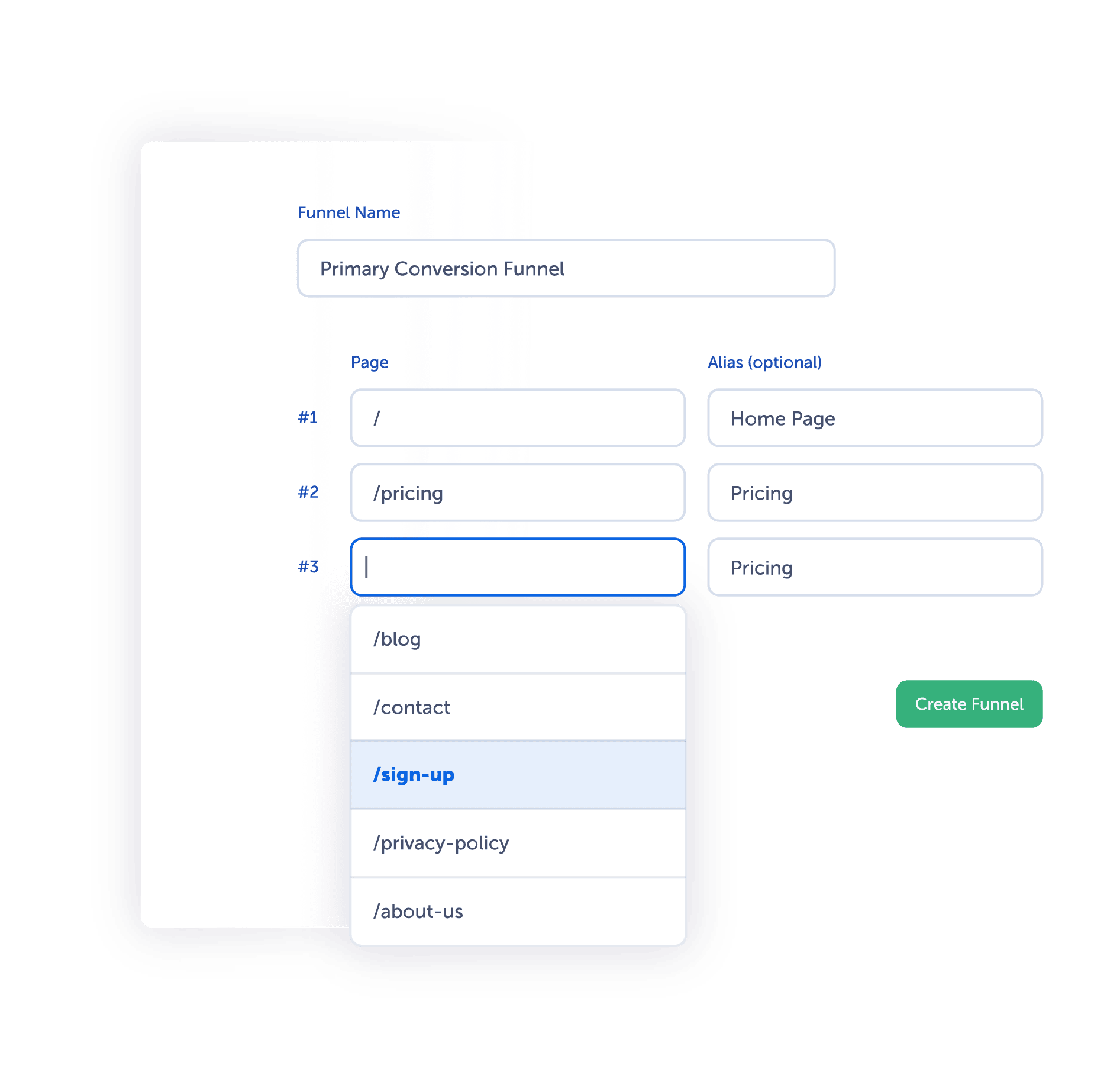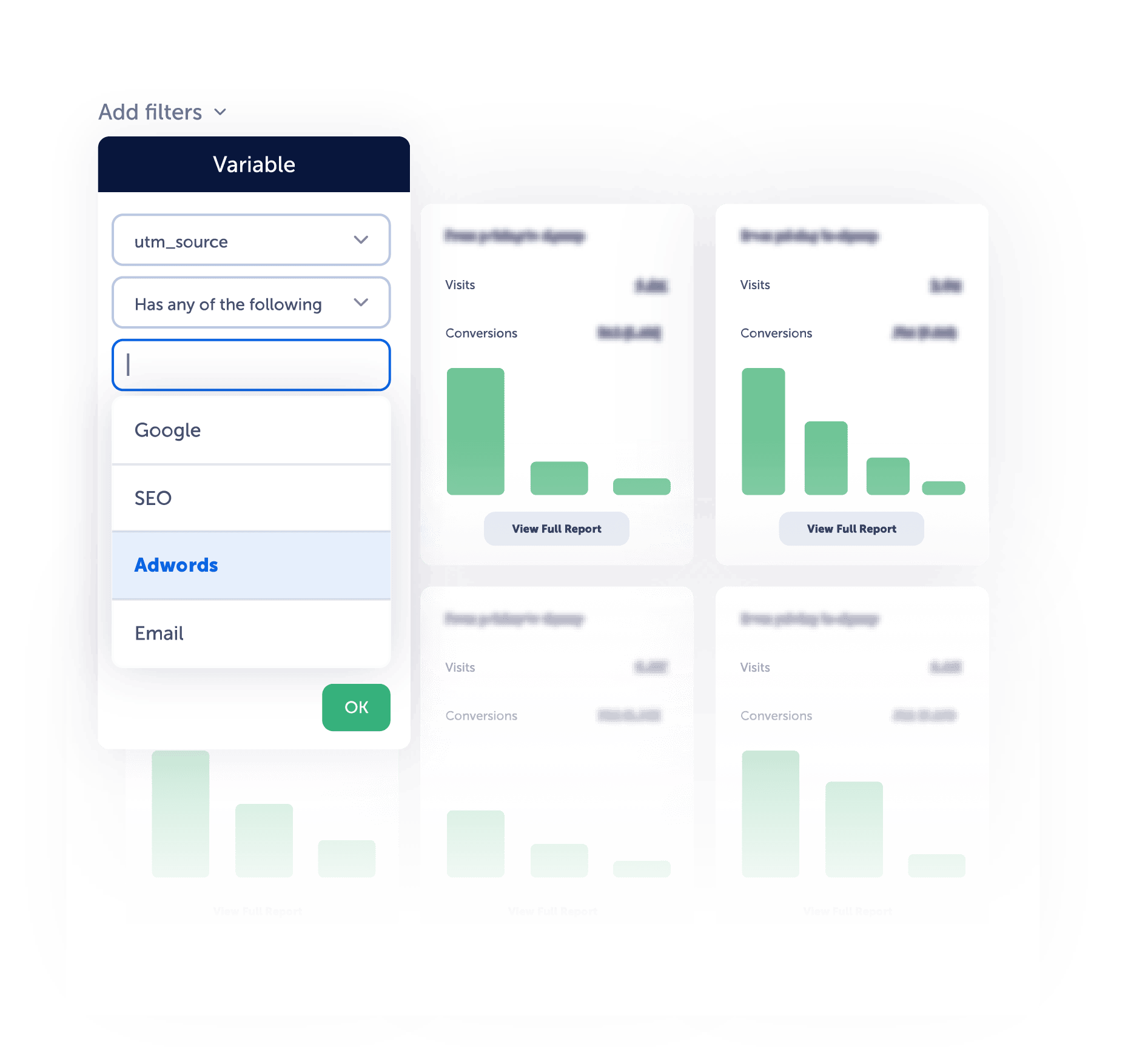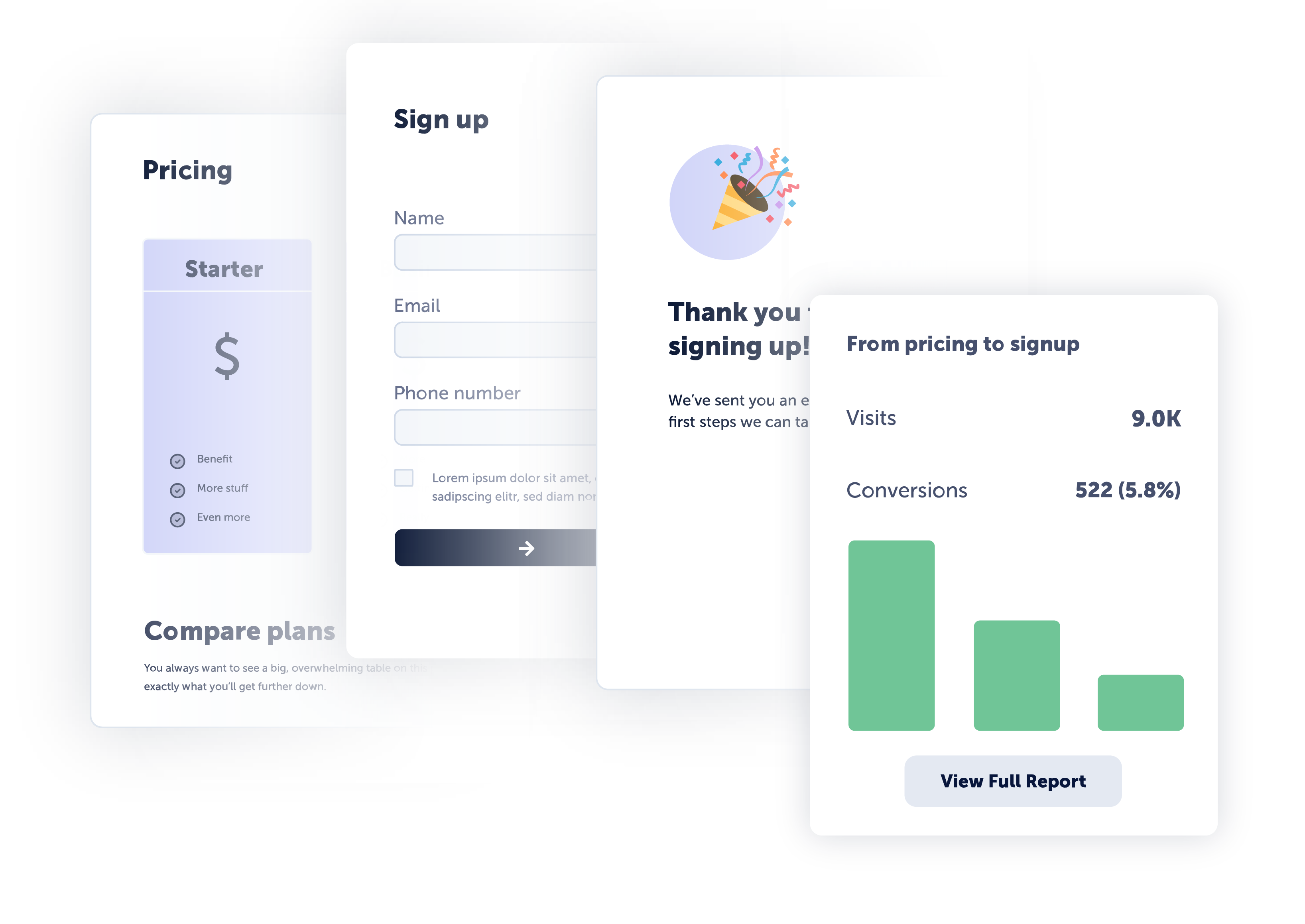Get better ROI from every funnel
Measure every step of the on-site customer journey — and watch actual recordings.
Simply input your website funnel URLs and Mouseflow shows conversion rates at each step. Compare journeys to find the most profitable path, channel, referrer, and more.
Watch session recordings of dropped and converted users to optimize your website’s user funnel.

Setup in seconds, look back up to 12 months
Define a funnel any time with up to a year of secure data storage.
From the moment you install and click record, Mouseflow records 100% of your traffic on 100% of your pages, by default.
So when a new hypothesis arises 3 months down the line, you can look back on performance of the newly defined funnel.
More sales, more leads, more signups
Improve eCommerce funnels, lead nurture journeys, email collection, and product onboarding.
Mouseflow enables checkout funnel analysis to identify path-to-purchase improvements.
Whatever your conversion funnel looks like — eCommerce, financial services, SaaS, telehealth, travel you name it — Mouseflow helps streamline the user’s journey.

Filter and tag for channel-specific funnel optimization
Analyze user journeys by source, region, device, campaign, and more.
A problematic campaign can throw shade on an otherwise healthy conversion funnel. With rich data segmentation, you can find sources with the best and worst ROI.
Enhance and integrate with your current tech stack to provide cross-platform web analytics and insightful deal tracking.
Questions you can answer using funnels
A funnel can help you identify what's the product that sells the most, as well as those who need a bit more work to get them to drive results.
Find out what pages aid conversion as your customer moves from step to step in the funnel.
Build a funnel to understand at which stage your customers are abandoning the process and what's making them do so.
Uncover what's distracting your prospects from conversion by replaying their sessions at each step of the funnel.
Set up a funnel for your TOFU, MOFU and TOFU blogposts and track how you move your visitors through your marketing funnel.
Conversion funnel optimization FAQ
More questions? We have answers.
A conversion funnel is the concept of catching a large audience’s attention to capture an interested group of prospective customers, bringing them on a journey to purchase (or conversion — lead generation, email signup, what have you).
Like a funnel that helps pour oil in your engine, you’re inputting a large amount and outputting a smaller amount. In the case of digital marketing, the common conversion funnel stages include:
- Top of funnel, often abbreviated TOFU, is the awareness and education stage. It looks at a broad topic to capture a broad, large audience.
- Middle of funnel, often abbreviated MOFU, is often broken into two or even three parts.
- Interest: Take those users interested in learning about a more specific topic in-depth from the awareness/TOFU stage to keep them engaged with the brand.
- Consideration: Take interested users from a learning-mindset to a solution-evaluating mindset. The goal is to begin considering your product or service as a solution to their problem.
- Intent or Desire: Take users considering your product to the point of intending or desiring to buy — but needing a final nudge.
- Bottom of funnel, often abbreviated BOFU, is the conversion or action stage. Depending on your business, this can be a purchase (ecommerce), sign up (product, SaaS), form submission (lead gen, B2B, healthcare), or even something as simple as watching a video.
Once a user converts at the bottom of the funnel, wise marketers invert the funnel to nurture the customer and build a supportive relationship. The post-conversion funnel stages could include:
- Retention
- Advocacy
- Repeat purchases
- Upgrades
- Referrals
- And more
Digital marketers, web analysts, UX designers, product managers, conversion optimization specialists and other professionals create, monitor, and optimize funnels to drive more and better qualified users to the conversion stage and beyond.
While a conversion funnel can be applied in many ways, it’s typically thought of as a way to group content and also outline an ideal or logical customer journey. Website conversion funnel analytics are an integral component of customer journey mapping.
But a customer journey is not necessarily a conversion funnel.
The customer’s journey probably won’t begin on your website. Nor will it take place solely on your site, either. A journey considers off-site content (yours, published elsewhere, or third-party) such as articles, reviews, and videos.
Depending on your marketing mix, the journey you own may include content, advertising, email, and social media.
But when evaluating the customer journey, it’s essential to look beyond your site.
A conversion funnel is most often thought of as the on-site (or at least owned content) experience. The first touch — perhaps an SEO landing page, homepage, or article — and then on to the next page, and the next… until that user reaches conversion. (And then the customer funnel begins!)
Your conversion funnel will be a part of the customer’s journey. But your customer’s journey will not take place solely within your conversion funnel.
Oh — and a conversion funnel is just an ideal scenario or a bust guess. That’s where funnel optimization comes in to evaluate a funnel, determine if it needs on-page changes or a different order, and update it to match the real, actual customer journey.
To build the best funnels, start with reviewing session recordings of converted users. You’ll begin to see patterns.
There are a few ways to build a conversion funnel. You can create net-new content that nurtures your prospect’s needs. You can go with your best, most logical guess.
Or, you can listen to real customer data — from session recordings, that is.
First, identify a group of converted users. Then, analyze the group’s on-site journeys. What pages are common between users? Which pages do users come back to more than once? Which pages do they retreat from? Which pages contain crucial pre-conversion information?
Common funnel touch points include:
- Home page
- Pricing
- Product/service descriptions
- Comparisons
- Testimonials (social proof)
- Conversion/cart/checkout page
Building a conversion funnel in Mouseflow is as easy as choosing the page URLs. Here’s a quick-start guide: 5 steps to conversion rate optimization with Mouseflow.
An ecommerce conversion funnel is a purchase path for online stores. Here’s a couple common examples.
Example 1:
- Homepage
- Category
- Product 1
- Product 2
- Shipping details
- Warranty info
- Checkout
Example 2:
- Product 1
- Category
- Product 2
- Homepage
- Category
- Product 3
- Checkout
Ecommerce sites typically develop unique funnels for different channels and audiences. A Facebook ad campaign may have one funnel (landing page, product, checkout), while an email newsletter may have another (blog, category, product, checkout).
Monitoring ecommerce conversion funnels with Mouseflow can lead to higher purchase and conversion rates as you understand which pages need improvement to avoid losing users.
Simply take the number of conversions divided by the number of visitors (in a given time frame), and turn it into a percent.
Example:
- A landing page sees 1,000 visitors
- 30 of those visitors convert — they purchase, sign up, download, etc.
- 30 / 1,000 = 0.03 = 3%
When using Mouseflow’s funnel optimization tool, you’ll see conversion rate for each page — how many visitors to page 1 made it to page 2? From page 2 to page 3? And so on.
When evaluating conversion rates and looking at funnels, remember to consider both the funnel as a whole and each individual stage.
In addition to funnel stage conversion rates, you can also look at the number of visitors that came to page 1 and made it all the way through to the finish line of conversion — that’s your funnel conversion rate.
Throughout your funnel, conversion between pages or stages may be more logically classified as a click-through, and therefore measured as click-through rate (CTR).
That said, it’s fair enough to say that click-through is a micro-conversion on the way to the primary conversion.
A good funnel conversion rate is one that’s improved over its last measurement! Assigning ideal funnel conversion rates by industry or other categories is helpful , but more importantly is benchmarking and improving.
Funnel conversion rates will also differ by stage of the funnel. You may see a much higher conversion rate from step 1 to step 2 (click-through), say 70%, than you do from step 4 to step 5, which might only see a 5% rate.
Funnel conversion rates are hard to benchmark by industry because of the variety of funnels and journeys created across the web.
But, if we’re talking single-page BOFU conversion rates, Unbounce has an industry-heralded research study of rates across industries. Some example industry conversion rates (median) include:
- SaaS: 3.0%
- Medical: 3.6%
- Travel: 4.8%
- Ecommerce: 5.2%
- Media/Entertainment: 7.9%
Yet keep in mind this is a rundown of website or landing page conversion rates, not funnel stage conversion rates.
See below for how these numbers are calculated (it’s not too tricky!).
We’re glad you asked! Read on for a quick overview, or you can head over to 5 steps to conversion rate optimization with Mouseflow for a more tactical guide.
After building your funnel, here are some metrics to analyze at a glance:
- Dropoff
- Conversion rate (by stage)
- Conversion rate (for entire funnel)
And with Mouseflow’s website conversion funnel analytics, you can dive deeper into dropped and converted sessions to see real user recordings and understand what helps and what hurts.
You can also identify a segment of users (say, dropped or converted, or from a certain region) and analyze their funnel performance — and other user behavior analytics.
Review session recording stats, see this segment’s behavior heatmaps, and make decisions that improve your channel, funnel, audience, messaging, UX/design, and more.
If you’re testing two versions of a page, Mouseflow makes it super-simple to set up a funnel for each to compare performance.
Simply build your first (A) funnel, then build it the same way, but replace the URL for the A page version for the B version’s URL.
Common tools like Google Analytics or Adobe Analytics provide you with a nearly never-ending store of data to mine. But where they fall short is in measuring, documenting, and visualizing on-page user behavior.
Mouseflow is often used by marketers, analysts, CROs, UXers, product managers, and others to add visual context to insights drawn from other analytics tools.
The tools can also be used complementary to each other in comparing data to understand the connection between incoming traffic and on-site experiences.
Mouseflow can also offer a more focused and more customized viewport for understanding your web analytics data. When it comes to conversion funnel optimization, recreating Mouseflow’s funnel analysis in other analytics tools will fall short — especially when it comes to watching actual user sessions, whether they dropped or converted.
You’ll be able to get even more out of your existing analytics tech stack by incorporating Mouseflow. And we make it easy to do so with integrations for your other platforms, too, including:
- Ecommerce platforms like Magento and Shopify
- CMS like WordPress, Wix, and Drupal
- Martech including HubSpot, Optimizely, and Unbounce
…. And more — check out all of our integrations.
Mouseflow’s recent accolades include:
G2 (Spring 2022): Top 100 Software Products and Top 100 Highest Satisfaction Products, Best Results, Best Usability, Highest User Adoption, Category Leader, Momentum Leader, Most Implementable, and Best Relationship.
Capterra Shortlist for Web Analytics Software 2022
Category Leader for Web Analytics Software
We’ll let you decide — check out real user reviews on GetApp, G2, and Capterra and look at similar tools side-by-side with our handy comparisons to tools like Hotjar, CrazyEgg, FullStory, Contentsquare, VWO, lucky Orange, and more. Read more about our recognition as the best web analytics software.
